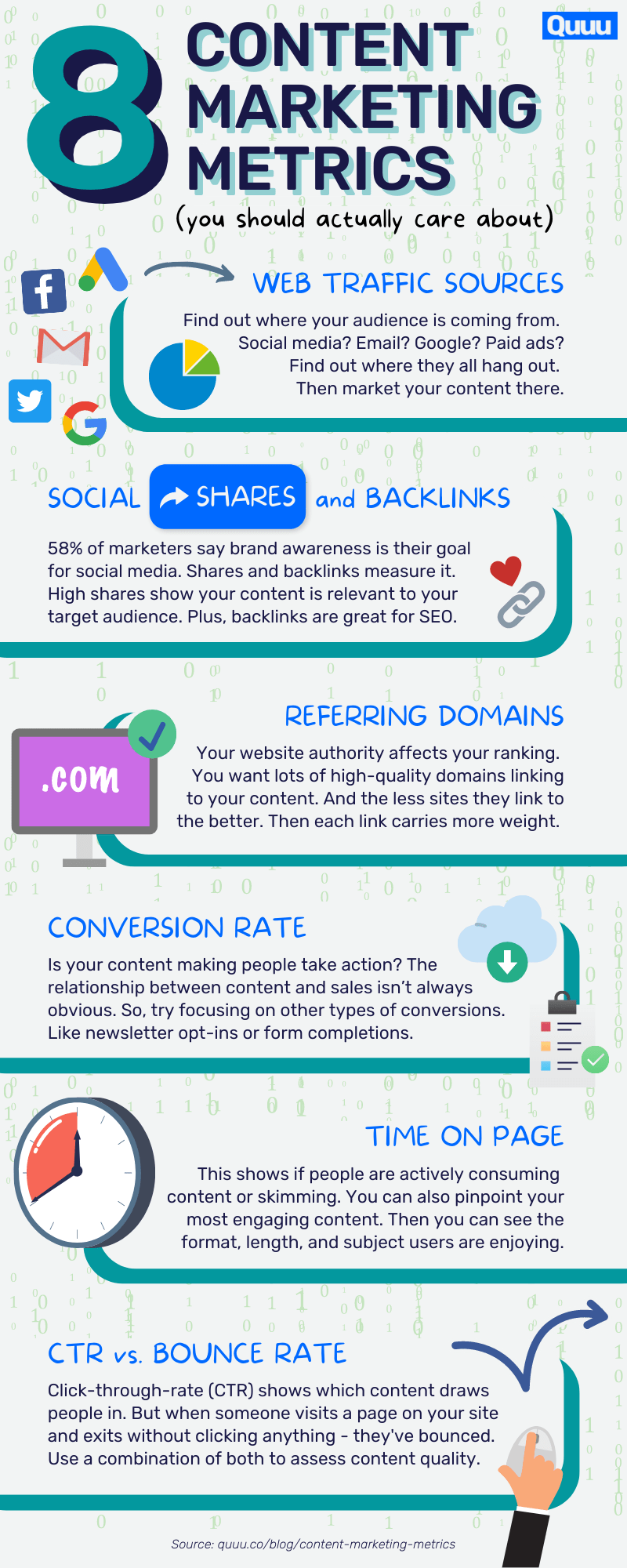Like any strategy, content marketing has a goal. You want to answer your target audience’s questions.
Do this enough and you’ll rise up Google’s SERPs (search engine results pages.) The higher you are, the more organic traffic you’ll get. It’s an awesome circle. If you can get it right.
Now, I know there are tons of articles on why you need to track content marketing metrics. But it’s actually very simple.
It takes time to create valuable content. And you want to make sure you’re spending it wisely. So, you need to keep an eye on each piece of content’s performance. Then make more of the good stuff.
You can do most of this for free, too. Using Google Analytics (GA) and any social media platforms you’re on. But there is a LOT of data here. So, focus on the most important metrics:
- Web traffic sources (where are people finding you)
- Social shares and backlinks (measure brand awareness)
- Referring domains (big impact on SEO)
- Conversion rate (see if your content is making people take action)
- Time on Page (suggests content quality)
- CTR vs. bounce rate (tells you if you’re answering search intent)

Web traffic sources – where are people coming from?
Everyone is obsessed with website traffic. And for good reason. But it’s almost too obvious to mention. Of course, it’s important. But what we want to know is where people are coming from.
SEO (search engine optimization) is about increasing your site’s visibility and new visitors. Through upping your rankings. And that only happens when you consistently create awesome content.
If you have no traffic, no one sees what you’re making. Which means it’s too terrible to bother looking at. Or you haven’t indexed properly. Double-check that. Then focus on your content quality.
If you have traffic, good for you. New to digital marketing and GA? “Pageviews” counts returning visitors. “Unique pageviews” doesn’t.
Now, the main web traffic sources are:
- Organic search – from sites like Google, Yahoo, or Bing
- Paid search – usually via PPC (pay-per-click) Google AdWords
- Direct – typing in your URL or arriving at your site directly
- Referral – from clicking a link on another site
- Social – clicking a link from social media
- Email – clicks from an email marketing newsletter

Source: Google Analytics
Our main 4 at Quuu are organic search, referral, direct, and social. If your content marketing efforts are working, your “organic search” click-through rate (CTR) should be highest.
But if you’ve got an email newsletter, congrats. They’re one of the most powerful types of content marketing. So, track your opt-ins. Each one could be a new lead.
Determining your traffic sources tells you a lot about your audience. Especially where they hang out. And knowing your audience is key to growth. That’s why these content marketing metrics are worth tracking.
Social shares and backlinks – measure brand awareness
Social media engagement metrics are things like followers, likes, and comments. They’re sometimes known as “vanity metrics”. Because they look good. But they’re hard to link to ROI. So, some people think they’re meaningless.
But what if your marketing campaign is focused on brand awareness? In that case, social shares show your high-quality content is hitting its mark. (Psst. Quuu can help with that.)
Sprout Social found the most common goals for social media are increasing brand awareness (58%). And community engagement (41%). It’s the same across all surveys:

Source: HubSpot
In this case, there are 2 that you should focus on. The most valuable engagement metrics for content creation:
- Social shares
- Backlinks
Social shares are (obviously) unique to social media. But backlinks happen anywhere out in the wild web.
Backlinks are basically a thumbs up from one site to another. They tell Google a site is legit. And they are super important for SEO:

Source: Backlinko
But they also show where your content is being shared on different sites.
Now, thousands of shares from low-quality sites may be great for brand awareness. But for SEO, not so much. Because site quality plays a really important part.
Referring domains over backlinks – big impact on SEO
Your website authority determines your rankings. Which is going to have a huge impact on your content marketing strategy. And a high one makes ranking organically much easier.
Yes, backlinks play a big part in this. But it’s actually the sites linking to you that count.
Domain Rating (DR) measures your website authority. Every SEO tool has this metric. But it’s named and calculated differently by everyone. Ahrefs use this one.
Yes, you have to pay for it. But all the insights are worth it.

Think of it like a video game. It’s way easier to go from levels 1-10 than 60-70. The higher you go, the more challenging it gets. But your rankings are directly related to it.
3 main elements calculate your DR:
- The number of websites linking to you – only dofollow links are counted
- The DR score of linking domains – higher is better
- The number of sites each referring domain links to – lower is better
Basically, you want as many high-quality domains linking to your content as possible. And the less sites they link to the better. It means each link carries more weight. Make sense?
There are exceptions, though. Content Marketing Institute suggests trying to get Wikipedia backlinks. They’re “nofollow”, so unlikely to help with SEO. But they can result in a ton of traffic as it’s so trusted.
Remember, SEO isn’t an exact science. A lot of it is guesswork. And it’s constantly changing. So, you might find a new growth hack that works for you. That’s why we trial and track all these content marketing metrics.
Conversion rate – is your content making people take action?
Return on investment. Those 3 words (or letters) can be a nightmare for marketing teams. Yes, we all want to see where our money’s going. But sometimes, it’s hard to pinpoint.
Successful content marketing should generate qualified leads that turn into sales. But it’s tough. Because the sales funnel doesn’t really exist anymore. Each user journey is different. And there are tons of touchpoints that people jump in and out of.

Source: SuperOffice
And it’s not just about selling products. Sounds silly. That’s obviously the end goal for most sales teams. But your current focus could be on other key metrics. Like increasing your domain rating or other KPIs (key performance indicators).
Other types rely on the number of conversions like:
- Email newsletter opt-ins
- Downloaded resources
- Form completions
- Demos booked
- Free account signups
But let’s say your marketing goal is to work out your content marketing ROI. You want to source your lead generation. You can create custom goals in Google Analytics. These will help you set and track conversion rates.
Check out this walkthrough:
You can also track CTA clicks on your blog posts. Then you can see who’s actually purchasing from your content. If it’s a low number, think about updating the copy on your CTAs. It can make all the difference.

Source: Marketing Examples
When it comes to content marketing, ROI can be tricky. The relationship between content and sales isn’t always obvious. So, maybe shift your focus to other types of conversions. Like getting people to sign up for your newsletter.
That’s much easier to track. And can have huge growth potential in the long run.
Time on Page – suggests content quality
Content marketing success relies on quality. People need to be invested in what you’re creating. It should be properly researched. And aim to solve your target audience’s problems.
But how do you know if you’re nailing this without asking? Well, a certain content marketing metric on Google Analytics called “Time on Page”.
You want to know the following:
- What’s the average time people are spending on your content?
- Are they quickly scanning a number of pages?
- Or reading a whole article?
Is it low? People could be skimming.

Source: GIPHY
Time on Page shows if people are actively consuming your content. It also lets you pinpoint your most engaging content. Then you can see the format, length, and subject users are enjoying.
Here are a few of Quuu’s blog posts. As you can see, the Average Time on Page varies:

Source: Google Analytics
From this, we can see our audience is finding ASMR marketing and content repurposing pretty interesting.
So, how can you keep your own users on your pages for longer? Try these ideas:
- Create long-form content (minimum 2000 words)
- Use the Skyscraper Technique
- Embed videos and infographics into articles
- Use interactive content
- Make sure your UX (user experience) is priority
That last one is super important. Customer acquisition will be tough if you don’t have a great UX in place. And retention even tougher.
CTR vs. Bounce rate – are you answering search intent?
Unlike a lot of the content marketing metrics here, a high bounce rate is not good. It’s calculated when someone visits a single page on your site. But they do nothing else on the page before exiting.
It can mean people aren’t finding what they need from your content. And that ain’t good for product pages. But it could also be down to a few other things:
- Slow loading times
- Irrelevant or low-quality content
- Badly-designed landing pages
- Poor UX
The average bounce rate also differs between types of websites:

Source: Backlinko
If it’s your homepage, don’t worry too much. If all your products are on other pages, you don’t want your users hanging about there anyway.
If you write a high-quality blog, don’t worry either. It could just be that people have found the answer they’re looking for. Which means you’ve nailed it.
So, what’s a good bounce rate generally? According to Semrush:
- 56% to 70% is on the high side (but there could be a good reason for this)
- 41% to 55% would be considered average
- An optimal bounce rate would be in the 26% to 40% range
Do some research into your industry average. Then take it from there.
The flip side – CTR
Click-through-rate (CTR) is the other side of the coin. Because it can tell you which content is performing best. We all want to aim for the top SERP spots for SEO because those get the highest CTR.

Source: Klipfolio
If you’re using paid search ads, a lot of things will affect CTR. Like your title, keywords, meta description, and CTA copy.
So, how do you work yours out? According to Google:
“CTR is the number of clicks that your ad receives divided by the number of times your ad is shown: clicks ÷ impressions = CTR. For example, if you had 5 clicks and 100 impressions, then your CTR would be 5%”
You can also use the Search Analytics feature in Google Search Console.

Source: Semrush
Use a combination of bounce rate and CTR to assess your content. Then use that to dictate what you create next. It’ll give you a much stronger base to work from. Based on real customer data.
Conclusion
These 8 content marketing metrics aren’t the only ones with value. But they’re some of the most important. Because they’ll tell you a lot about your audience.
They’re all pointless without one thing, though. Quality content.
Before tracking any metrics, assess everything you’ve created. Is your audience searching for the keywords you’ve used? Does each piece of content answer search intent? Is most of your blog outdated and irrelevant?
These are all things you need to fix first. But once you do, you’ll have well-researched, valuable content you’re proud of. Then, these metrics can help you take it from there.
Which content marketing metrics do you put the most time into? Is there one on the list that’s more important than the rest? We’d love to hear your view in the comments.





